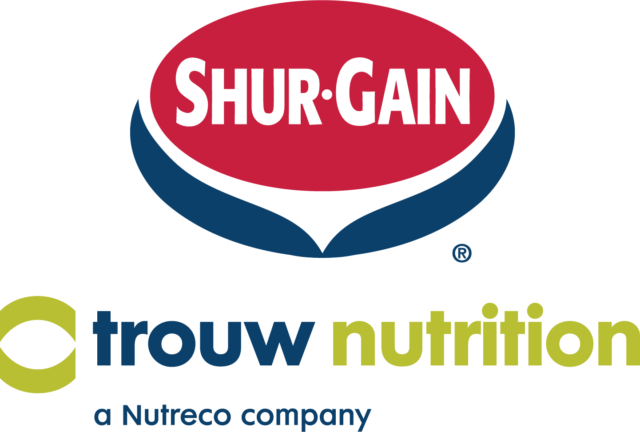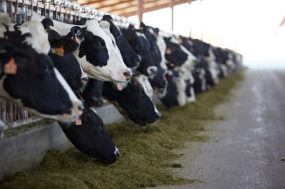The transition period from the dry period to lactation is a vulnerable time for the dairy cow because she experiences several physiological, metabolic and behavioural challenges. Dry matter intake (DMI) typically decreases prior to calving, and the subsequent increase in nutrient demand with lactation puts cows into a state of negative energy balance (NEB). This state of NEB is inevitable; however, the degree to which the cow will experience NEB will influence her risk of experiencing metabolic disease and will ultimately dictate her success through the transition period.
One of the risk factors associated with metabolic and infectious disease post-calving, and also associated with reduced DMI, is pre-calving body condition score (BCS). Over-conditioned cows (BCS of 3.5 or greater) not only eat less feed but are also at greater risk of excessive body fat mobilization. From a nutrition standpoint, it can be a challenge in the dry period such that cows neither lose nor gain, but rather maintain body condition. One extensively researched opportunity has been to focus on feeding dry cows to 100% of their nutrient (primarily energy) requirements. This concept has become very popular in the industry and has resulted in improved energy balance post-calving.
One widely accepted strategy to control energy intake in the dry period is to incorporate large amounts of low-nutrient-dense feedstuffs, such as wheat, oat or barley straw, into the diet. This type of diet is referred to as a "controlled energy dry cow diet" or is also commonly referred to as the "Goldilocks diet." The goal of these diets is to control energy consumption and maintain BCS, and thus promote metabolic health while also encouraging voluntary intake, feelings of satiety and rumen fill.
However, from a feeding behaviour standpoint, there are areas of concern with such diets. For example, straw is not considered very palatable to the cow, which could increase the risk of sorting. Sorting in the dry period increases the risk that cows do not end up consuming the intended diet and, thus, the targeted nutrient consumption. Moreover, straw is bulky and when incorporated at high rates, particularly with long particle size, can extend rumen retention time and increase rumen fill, leading to reduced DMI. And lastly, large amounts of dry straw make the dry cow diet very different from the fresh cow diet in terms of physical characteristics. The pre-fresh diet is often bulky and lower in moisture content, whereas the fresh cow diet is typically denser with greater moisture content. These differences, coupled with significant drops in DMI in the weeks leading up to calving, can make it particularly difficult for cows to adapt to this dietary change, especially from a behavioural standpoint.
Despite the potential challenges of these diets, there are opportunities to make the pre- and post-fresh diets more similar to one another by manipulating certain physical characteristics. In a series of three studies on feeding high-straw dry cow diets, we observed that by manipulating forage particle size, moisture content and overall palatability, we can minimize the physical differences between the pre- and post-fresh diets, while making these dry diets more desirable to the cow.
In the first study, we fed dry cows high-straw dry cow diets that were nutritionally the same but differed in the chop length of the wheat straw in the diet. Straw was chopped either with a 2.54-centimetre (1-inch) screen or with a 10.16-centimetre (4-inch) screen. Cows fed the diet with the shorter-chopped straw had greater DMI across the dry period and, interestingly, were able to maintain more consistent intake in the seven days leading up to calving compared with cows fed the longer-chopped straw. As predicted, cows fed the short-chopped straw also sorted that diet less.
It is noteworthy that rumen health was improved during the first week of lactation for cows fed the short-chopped straw dry cow diet, as evidenced by less of a decline in mean rumen pH level following the transition onto the lactating diet. This may have partially been driven by the consistency in intake for those cows in the week leading up to calving. We also observed a tendency for cows fed the short-chopped straw to have lower blood beta-hydroxybutyrate (BHB) levels three weeks post-calving, suggesting again that this more consistent intake in the week before calving may have led to improved energy balance post-calving.
Despite these benefits, a significant amount of sorting was still observed in that first study. Another strategy thought to minimize sorting and promote more consistent intake is water addition – because the water may help bind the smaller particles to the larger particles, making the diet physically more difficult to sort. Because controlled energy dry cow diets contain a large proportion of dry forages, they may also benefit from additional water. Another potential benefit is: Water addition may help to further minimize the physical differences between the dry and lactating diet by making the dry matter (DM) percentage, and thus overall density, more similar between the two diets.
Thus, in our second dry cow study, we fed cows either a high-straw dry cow diet with no water added (DM = 53.5%) or a high-straw dry cow diet with water added to decrease the DM content by approximately 10% (DM = 45.4%). Cows fed the diet with added water sorted that diet less, had greater intake across the dry period and were able to maintain more consistent intake in the week leading up to calving compared with cows fed the control diet.
Similar to the first study, cows fed the diet with added water had greater mean rumen pH during the first week post-calving and tended to have greater mean rumen pH during the second and third week after calving. This finding is also similar to the first study and, once again, may be attributed to more consistent intake (in amount and composition due to less sorting) in the week leading up to calving, as well as greater intake across the entire dry period, which may have led to greater development of the rumen papillae and increased absorptive capacity of the rumen.
After these studies, we wanted to determine if improving the overall palatability of the diet may have even more beneficial impacts on transition cow performance. Molasses, as a source of sugar, is not only palatable but also helps reduce sorting and supports fibre-digesting bacteria. Thus, for our third study, we fed cows a high-straw dry cow diet with either no liquid feed supplementation or molasses-based liquid feed supplementation at 1 kilogram per cow per day (DM basis). When fed the diet with added molasses, cows sorted less and had greater intake across the dry period, and maintained more consistent (and greater) intake in the week leading up to calving compared with cows fed the control diet.
During the dry period, cows supplemented with the molasses had higher rumen pH. Post-calving, cows previously fed the diet containing molasses continued to maintain a more stable rumen environment, as demonstrated by higher mean rumen pH during the first two weeks of lactation. Molasses-fed cows had, on average, lower maximum blood BHB concentrations in the first week post-calving, indicating improved energy balance.
While improvements to controlled energy dry cow diet composition can be made, and informed through such research we have done, it is important to note that the success of such diets may rely on outside factors, such as bunk management, which can greatly influence the cow’s feeding behaviour and, ultimately, her intake.
As with lactating cows, continuous feed availability for dry cows is greatly important. One aspect of this is to manage stocking densities to maintain sufficient feeding space (76 centimetres [30 inches] per cow or greater). Another aspect is to keep feeding levels high enough so the feedbunk is never empty. Feed push-ups are also an important aspect of feed availability. Pushing up feed continuously throughout the day is critical for ensuring cows consume a balanced diet and that they have continuous access to feed. Push-ups can help promote consumption of a balanced diet by mixing up the feed in front of the cows and minimizing any existing locations of sorting. This is increasingly important when cows are fed a diet with ingredients that may be deemed less palatable, such as straw, and when diets are more easily sorted because of their physical characteristics. Dry cow diets should also be mixed and delivered at least daily, and potentially more often in periods of high environmental temperature and humidity and in situations where the aerobic stability of any silage in the dry cow diet is less than desired.
In conclusion, controlled energy dry cow diets are beneficial from a metabolic standpoint, as demonstrated by supporting research and adoption of this feeding strategy in the industry. Equally important, however, is the role feeding behaviour plays in the cow’s success through the transition period. Manipulating the physical characteristics (i.e., greater density through smaller straw particle size and water addition) can make these dry diets more physically similar to lactating diets; this strategy has proved to be beneficial from both a behavioural and metabolic and rumen health standpoint. Further, improving the palatability of these high-straw diets through the use of a molasses-based liquid feed also proved to be beneficial for optimizing transition cow performance. Nutritional considerations for these types of diets, albeit important, are only one piece of the puzzle. How these diets are managed at the feedbunk to ensure good and continuous availability and access also play a critical role in the overall success of dietary management in the transition period.







